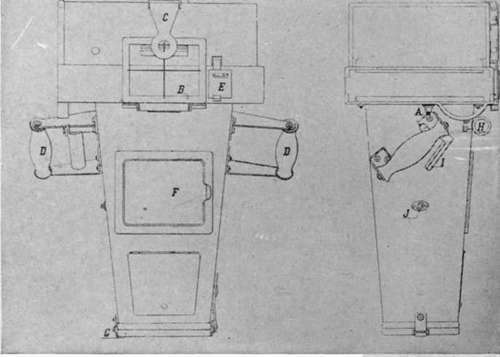Representative Types Of Hand Held Cameras
Description
This section is from the book "Airplane Photography", by Herbert E. Ives. Also available from Amazon: Airplane photography.
Representative Types Of Hand Held Cameras
French And German Hand-Held Cameras
French And German Hand-Held Cameras are essentially smaller editions of their standard long-focus cameras, and a description of them will apply to a considerable extent to the large 7 rules are laid down, but experience has shown that a fairly heavy camera—as heavy as is convenient to handle—will hold steadier than a light one. The American 4X5 inch cameras described below weigh with their magazines in the neighborhood of twelve pounds cameras to be discussed in a later chapter. The English and American hand-held cameras are generally quite different in type from the large ones, which are used attached to the plane.
The French Hand-Held Camera
The French Hand-Held Camera uses 13X18 centimeter plates, carried in a deMaria magazine, and has a lens of 26 centimeters focus. The shutter is the Klopcic self-capping type already described, and is removable. The camera body, built of sheet aluminum, takes a pyramidal shape. In Fig. 38, A is the shutter release and B the rectangular sight, of which C is the rear or eye sight. The complete sight may be placed either on the top or on the bottom of the camera. At D are the handles, sloping forward from top to bottom; E is a catch for holding the magazine; Fis a door for reaching the back of the lens and the lens flap; G is a snap clasp for holding the front door of the camera closed; H is a ring for attaching a strap to go around the observer's neck; J is the lever which opens the flap behind the lens and releases the focal-plane shutter; J is a snap catch for holding the front door of the camera open.

Fig. 38. - Diagram of French (deMaria) 26 cm. focus hand camera, using 18x18 cm. plates.
The operations with this camera are three in number. Starting immediately after the exposure, the camera is pointed lens upward and the plate changed by pulling the inner body of the magazine out and then in; next the shutter is set; then the camera is pointed, and finally exposed by a gentle pull on the exposing lever.
The English Hand-Held Camera (Fig. 186)
This differs from the French in the size of plate (4X5 inch), in the shape of the camera body, which is circular, and in the type of shutter, which is fixed-tension variable-opening. In the longer focus camera (10 to 12 inch) the shutter is self-capping, and the aperture is controlled by a thumb-screw at the side. In the smaller (6 inch) a lens flap is provided in front of the lens and the shutter aperture is varied by a sliding saddle and cord. The handles of the camera are placed vertical, instead of sloping as in the French. The shutter is released by a thumb-actuated lever. Double dark slides are used, as the multiple plate magazine has not found favor in the English service.
The German Hand-Held Camera (Fig. 42)
The German hand-held camera is, like their whole series, built of canvas-covered wood, the body having an octagonal cross-section. It is equipped with the lea shutter and uses the Ernemann six plate (13X18 cm.) magazine. The excellent system of grips by which the camera is held and pointed is an especially commendable feature. On the right-hand side is a handle similar to the French type, but carefully shaped to fit the hand. The left-hand grip consists of a long, rounded block of wood running diagonally from top to bottom of the side, with a deep groove on the forward side for the finger tips, while over the hand is stretched a leather strap, the whole aim being to provide an absolutely sure and comfortable hold on the camera during the plate changing and shutter setting operations.
Continue to:
Tags
camera, lens, airplane, aerial, film, exposure, photography, maps, birdseye
